By Peter J. Nash
May 27, 2014
 |
Two historic baseballs purported to have broken records as the “world’s fastest pitch” once withdrawn from a 2013 auction because of authenticity issues are now back on the market at Love of The Game Auctions in New Jersey. The auction house states that the balls alleged to have been thrown by Nolan Ryan and Bob Feller originated from the “noted collection of Barry Halper” and that the consignor purchased the pair for $4,312 in the 1999 Halper Collection auction at Sotheby’s.
The auction house currently has four bids on the lot but makes no mention that the balls had previously appeared as lot 127 in Ken Goldin’s 2013 sale and that they had been withdrawn due to their dubious Halper provenance and questions raised by a 1974 wire photo that surfaced showing Ryan holding a different ball marked “100.8.” LOTG’s Al Crisafulli says his consignor didn’t tell him about the previous withdrawal from the Goldin auction.
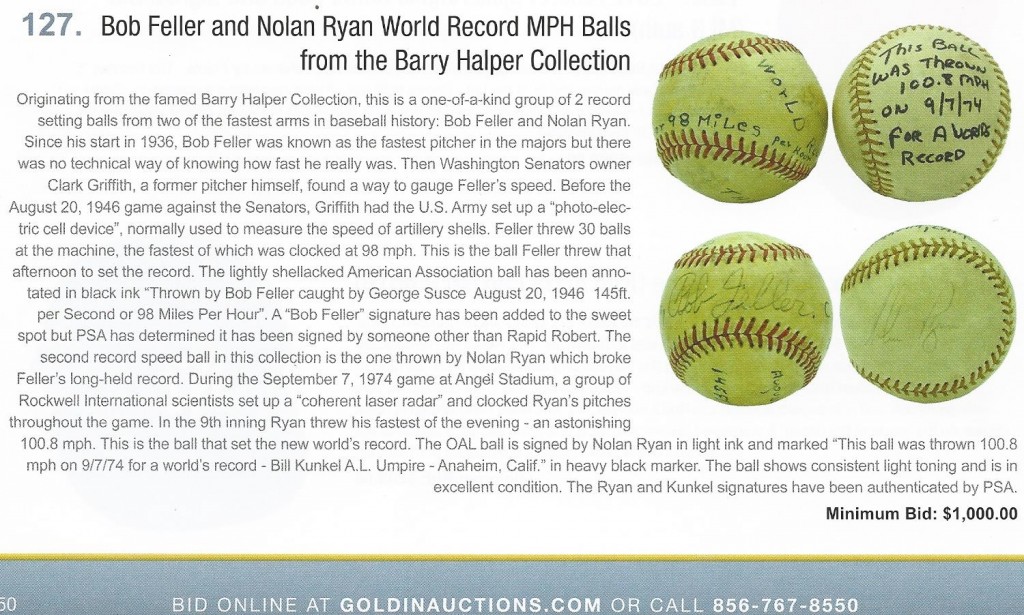
The alleged Ryan & Feller record "fast-balls" were removed from a Goldin Auctions sale in 2013 when their authenticity was questioned.
The auction house also failed to mention in its original lot description that the Nolan Ryan ball, even if it were authentic, is identified as being pitched at 100.8 mph on September 7, 1974, when Ryan had actually established the record over two weeks earlier at 100.9 mph on August 20, 1974. In LOTG’s lengthy write-up about the history of the two events they linked to an article published on the website efastball.com but they failed to include the information that the record was broken on August 20th and that the Guinness World-Record was established on that same date, not on September 7th.
After being contacted by Hauls of Shame, the auction house amended its lot description to indicate that the date and speed indicated on the Ryan ball corresponds with his second fastest pitch and not the recognized World Record by Guinness (although the inscription on the ball states differently). When asked about the wire photo showing Ryan holding a different ball marked “100.8″ on September 7, 1974, LOTG’s Al Crisafulli responded stating, “I think it’s entirely more likely that the ball Ryan is holding in the wire photo is a prop, as there is nothing I’ve seen to indicate that anyone is stating that said ball is THE ball Ryan threw. All that photo says, to me, is that Nolan Ryan threw a baseball 100.8 mph.”

Barry Halper's alleged "fastest ball" says Ryan broke the world record on Sept. 7, 1974, while the Guinness book of World Records shows he broke the record on Aug. 20, 1974.
The other offered baseball alleged to have been thrown by Bob Feller in 1946 at 98.6 mph has its own issues considering it features a forged Feller signature that Love of The Game describes as a “clubhouse” autograph signed on an Official American Association baseball. Feller established the record right before the start of a game against the Washington Senators and the likelihood he would have used a non-Major League ball from a league that included teams unaffiliated with Cleveland and Washington (and located hundreds of miles from Washington D.C. in the Midwest) is highly improbable. What’s even more improbable is that Bob Feller wouldn’t have signed his own record breaking baseball and that Barry Halper wouldn’t have had him sign the ball at some time after he had acquired it. Even Bob Feller’s son can’t see how the ball could have been positively authenticated without input from his late father.
When the balls were first offered at Sotheby’s in 1999 Halper and his associate, auctioneer Rob Lifson, never divulged any additional information regarding the provenance for the balls besides the say-so of Halper who claimed that they were the authentic and original record-breaking orbs. Fifteen years after that $20 million plus landmark sale, the hobby is more well informed and aware of Halper and Lifson’s sales of over two million dollars worth of fakes and fraudulent items via Sotheby’s. In the 1999 Sotheby’s sale, Richard Russek and Andy Imperato of Grey Flannel authenticated hundreds of thousands of dollars of counterfeit uniforms and jerseys that Halper falsely claimed came from the collection of ex-Brooklyn Dodger Ollie O’Mara as well as others including Stan Musial’s rookie jersey and Mickey Mantle’s 1956 Yankee jersey. Other fakes included Lou Gehrig’s alleged “last glove“; Ty Cobb’s dentures and Halper’s famous “500 Home Run Club signed sheet,” which Halper falsely claimed was signed in person for him by both Babe Ruth and Jimmie Foxx.

Halper's plaque honoring him and the "Halper Gallery" was removed from the Baseball Hall of Fame and Museum after reports revealed items he sold to MLB were bogus including Joe Jackson's 1919 jersey (center). Halper and current HOF Chairman Jane Forbes Clark cut the ribbon opening the now defunct Halper Gallery in 1999.
Further destroying Halper’s credibility are another million dollars worth of bogus Joe Jackson and Mickey Mantle artifacts he sold MLB and the Baseball Hall of Fame in 1998. Halper lied and claimed that he acquired Mantle’s rookie jersey from Yankee clubhouse man Pete Sheehy and that he purchased Jackson’s 1919 jersey and “Black Betsy” bat from Jackson’s widow in the 1950s when he was attending the University of Miami and pitching for Jimmie Foxx. As it turns out, Halper never even played for the Miami nine and Foxx wasn’t even on the staff at the time he attended the school. The recently well documented exposures of Halper’s large-scale fraud even prompted the Baseball Hall of Fame to remove the Barry Halper Gallery from the Cooperstown museum.
Safe to say, an auction house in 2014 can’t just offer two baseballs they claim to be record-breakers by Nolan Ryan and Bob Feller just because they originated from “noted collector” Barry Halper with only his word supporting their authenticity. Ironically, it was Bob Feller who described best how shady the hobby can be when he told the New York Daily News, “This memorabilia business is a racket. If people want to throw their money away, they should go to Las Vegas. At least in Las Vegas, you get a good meal.”
The problems with both of the alleged record-breaking balls are significant. Here’s a break down of the issues regarding the authenticity of both baseballs:
The Alleged Nolan Ryan “Fastest Pitch” Baseball:
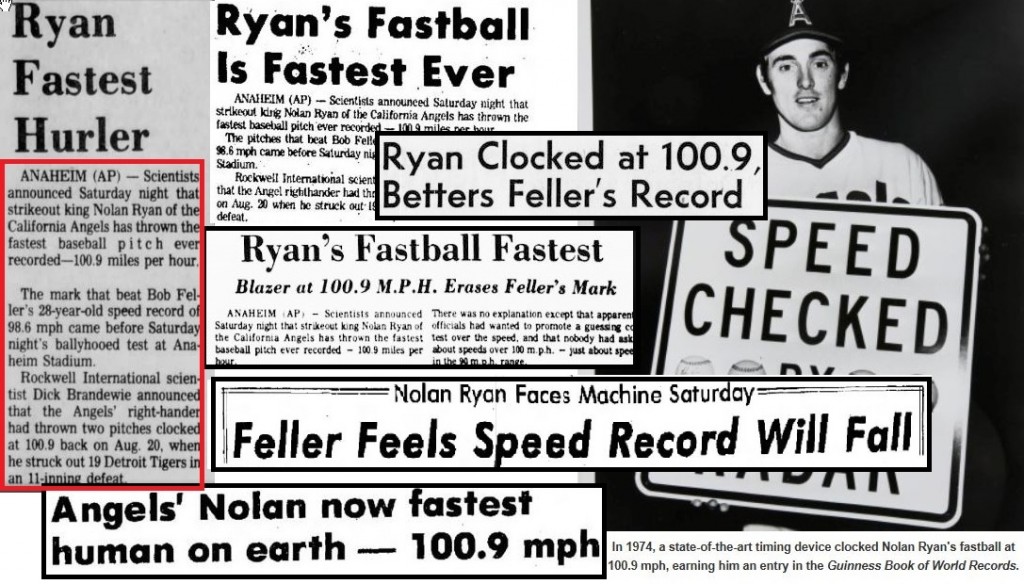
Nolan Ryan's world record pitch of 100.9 mph was reported prominently in the national and local press after it was announced before an Angels game on Sept. 7, 1974.
1. Nolan Ryan’s alleged record-breaking ball is dated from a game in which Ryan’s fastest pitch was not delivered–on September 7, 1974. Before the game that day, scientists from Rockwell International announced that Ryan had already established the record weeks earlier against the Detroit Tigers when he threw a pitch clocked at 100.9 mph. The September 7th game was intended as a promotional opportunity for the Angels organization to have fans guess how fast Ryan could pitch and if he could break the 100.9 record established on August 20th. Ryan failed to break the record reaching the highest velocity of 100.8 MPH in the ninth inning versus the Detroit Tigers. (Despite the announcement before the game of the actual world record the Angels incorrectly identified the 100.8 pitch as a “new record” on the scoreboard. On September 16th, Sports Illustrated also misidentified the 100.8 mph pitch as the “world record.”)

The EFastball.com article that LOTG links in its lot description clearly states that the Ryan record was broken on August 20, 1974 and Ryan's top speeds per inning were posted on the stadium scoreboard at the end of the game when he failed to break his own record on Sept. 7, 1974.
2. The Halper Collection baseball was described at Sotheby’s as having been inscribed by AL umpire Bill Kunkel who worked the infield during that game. Kunkel allegedly identified the 100.8 MPH pitch as being a record breaking event, but having been on the field that day how could he make such a claim? It was announced in the stadium that 100.9 mph was the record and the Angels crowd was aware that Ryan failed to break his own record as the highest speeds were posted on the scoreboard at the end of each inning. It was also reported prominently after the game in local and national newspapers that the record of 100.9 was set weeks earlier and announced before the game played on September 7th.
But more importantly, could a professional umpire working the infield have had the opportunity to retrieve the actual baseball thrown for the 100.8 mph pitch when the speed wasn’t reported until after the game was over? The actual 100.8 mph pitch was the third ball thrown to the lead-off hitter, Bee Bee Richard, in the ninth inning. According to accounts of that game, Richard walked and the following batter hit into a double play. The next batter, popped out to the catcher to end the game. A source familiar with MLB’s video archive told us that it was likely there was no surviving video from that Angels-White Sox game in 1974 to check for foul balls hit into the crowd. It is unlikely that the 100.8 mph ball survived the entire inning but, even if it did, could Kunkel have retrieved it from Ryan’s own catcher? Wouldn’t Ryan’s catcher keep the ball or give it to Ryan himself? Could Kunkel have even known to retrieve the 100.8 mph pitch when it wasn’t announced until after the game?
On September 16, 1974 Sports Illustrated reported how “artifacts damaged by Ryan pitches (were) treasured like war souvenirs” by players. At the time, SI reported that Angels catcher Aurelio Rodriguez, wore “a twisted medallion that a Ryan fastball blasted after a mix up in signals” and that Umpire Jim Evans saved a “face mask disfigured by a deflected Ryan pitch.” While its clear that Ryan souvenirs were popular, its a logical question to ask why Bill Kunkel would have ended up with the 100.8 mph ball instead of Ryan?
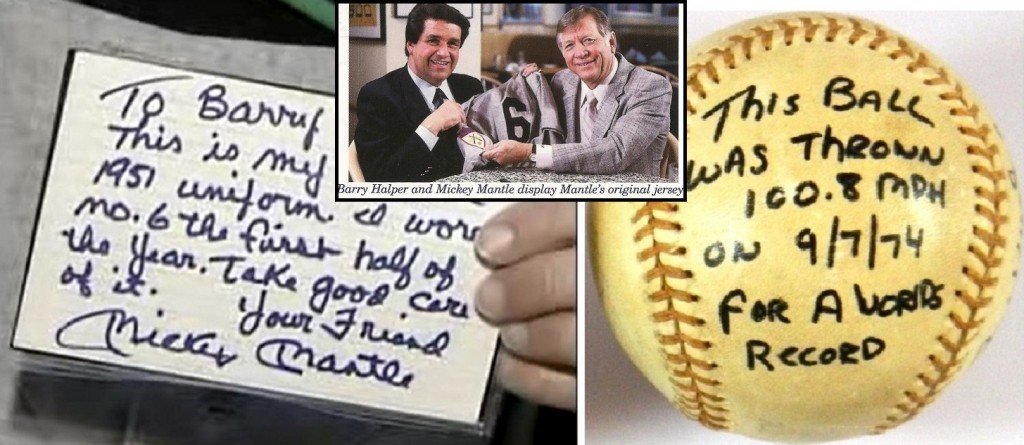
Barry Halper tricked Mickey Mantle into authenticating a bogus jersey he claimed was from his rookie season. Mantle inscribed a card and the jersey itself at Halper's direction (left). Could Ump Bill Kunkel's inaccurate inscription on the alleged Ryan ball have been coached by Halper as well?
3. It also appears that the JSA and SGC-authenticated inscription written by umpire Bill Kunkel was written at a later date than the Nolan Ryan signature which exhibits all of the characteristics of a signature originally signed on the ball in the 1970s. The Kunkel writing, executed in dark unfaded marker ink, appears to have been signed more recently. It has been established that Barry Halper often asked players and officials to inscribe artifacts and write LOA’s on index cards and it has also been established that he directed players to write inscriptions for totally bogus and fabricated material. The best example of this Halper practice was his directing Mickey Mantle to authenticate what Halper claimed was his 1951 Yankee rookie road jersey with the number “6.” Although Mantle inscribed and signed a card claiming it was his actual jersey from his rookie season, the jersey, which was purchased by MLB in 1998, was uncovered as a fake and later returned to Halper despite Mantle’s Halper-coached letter of authenticity. How can anyone say definitively that Halper didn’t orchestrate a similar scenario with Kunkel? It is very possible that Kunkel kept a game-ball from that night as a souvenir, but it is highly improbable that he would have been able to procure the actual 100.8 mph pitched ball.
4. Nolan Ryan was photographed on Sept. 7, 1974, holding a baseball marked “100.8″. Was that the actual baseball that broke the record? It’s clearly not the baseball offered by Halper or LOTG, but could it have also been a ball marked just for the photo opportunity? Throughout his career Ryan was photographed holding actual record-breaking balls or balls inscribed to represent the record-breaking event. But considering how the pitches were clocked and reported to the crowd only after each inning, could anyone on the field have even known which ball thrown by Ryan was actually the 100.8 mph ball? Why would anyone go to the lengths to retrieve the 100.8 mph pitch ball when it failed to break the pre-existing record? And wouldn’t Nolan Ryan be the most likely candidate to take home the “100.8″ ball if it actually existed?

These genuine baseballs from Nolan Ryan's no-hitters and milestone strikeout games are currently displayed at the Nolan Ryan Museum in Alvin, Texas. The museum does not have a baseball on display representing the Guinness World Record for "fastest pitch." (The Nolan Ryan Museum)
5. Nolan Ryan and his wife Ruth saved most all of the milestone baseballs from his MLB career and several are currently displayed by the Nolan Ryan Foundation at the Nolan Ryan Museum in Alvin, Texas. The displays do not include a ball that is identified as the one Ryan pitched when he established the Guinness World Record on August 20th or the one he pitched on September 7th. When presented with images of the Halper/LOTG baseball and the LOTG lot description, a representative from the Ryan Museum responded to the Hauls of Shame inquiry stating, “We are unable to authenticate the validity of this baseball.” Sources also indicate that Ryan never retained any souvenirs from the record-breaking “fastest pitch” events.
The Alleged Bob Feller Speed Record Baseball Thrown In 1946
1. Bob Feller’s alleged record-establishing baseball is an Official American Association ball that dates from the 1945 to 1947 era. This fact is the most problematic aspect regarding the authenticity of this ball since Bob Feller threw his 98.6 mph pitch at Griffith Stadium in Washington D.C. just before the start of an MLB game between the Cleveland Indians and the Washington Senators. The apparatus to measure Feller’s pitch was set up just before the game and the pitches were clocked during Feller’s warm-up for the game that day. Neither the Senators or the Indians had any affiliation with or any minor league clubs in the American Association. In fact, the teams in the American Association were located in the midwest from Columbus, Ohio all the way west to Kansas City. Why would an MLB pitcher like Feller have used an American Association ball in a promotion organized by Clark Griffith and the Senator organization in an MLB ballpark, just before an MLB game and during his warm up for that very game?
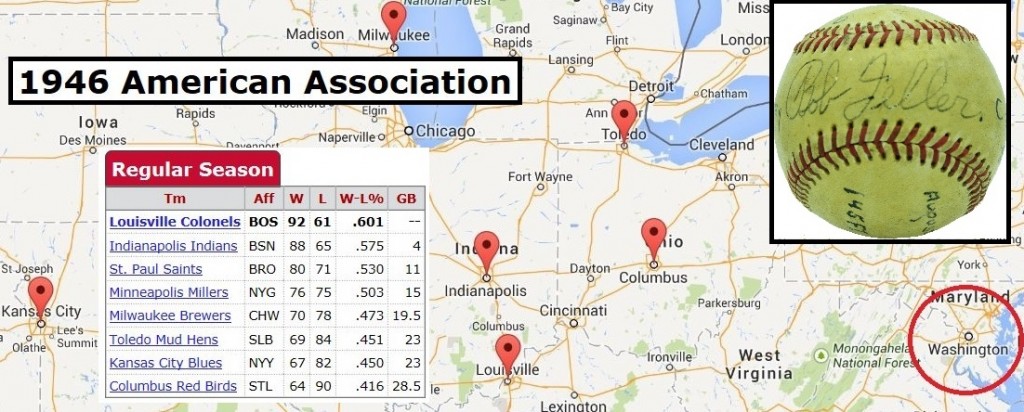
Halper's alleged Feller ball is an official American Association ball but Feller set his record in an MLB ballpark while he was warming up for a game against the Senators. Neither the Indians or the Senators had minor league clubs in the AA and the teams in that league were all located hundreds of miles away from the Washington D.C. ballpark.
2. The fact that the Bob Feller signature on the ball has been deemed non-genuine by JSA, PSA/DNA and SGC is also a significant sign that the ball may not be genuine. LOTG describes the signature as a clubhouse signature but it does not resemble Feller’s signature c.1946. The forged signature shows more characteristics of Feller’s autograph later in life making it difficult to figure out when it was actually placed on the ball. What’s even more puzzling is that Feller was easily accessible to sign items during his lifetime and he signed numerous items specially for Halper on numerous occasions including the famous “last bat” Babe Ruth used for “Babe Ruth Day” at Yankee Stadium in 1948. Feller re-acquired that bat, but not from Halper, and told Baseball Digest in 2005, “That bat is in my museum right now in Van Meter, Iowa. I got that bat back. It took a long time to get it, but I got it back. One of my teammates took it and hid it after Babe signed it, and then I bought it back from a fellow that won it in a contest after (collector) Barry Halper sold all his memorabilia.”
The fact that Halper didn’t have Feller inscribe the ball and recount his record breaking feat is also highly suspicious. It begs the question as to whether Feller would have agreed that it was actually the record-breaking ball? We contacted Bob Feller’s son, Steven Feller, who sits on the Board of Directors of the Bob Feller Museum in Van Meter, Iowa, and asked whether he knew of the Halper ball or any other 1946 record-baseball. Feller responded and said, “This is a rather fascinating “signature” ball being auctioned. Sorry I didn’t get back to you sooner, however I wanted to speak to both of my brothers to see if they had any recollection of our Dad ever speaking of or making any reference to this baseball. Both my brothers and I had never heard any mention of it from him ever. Very interesting question as to how can it be authenticated if not from my Dad?”
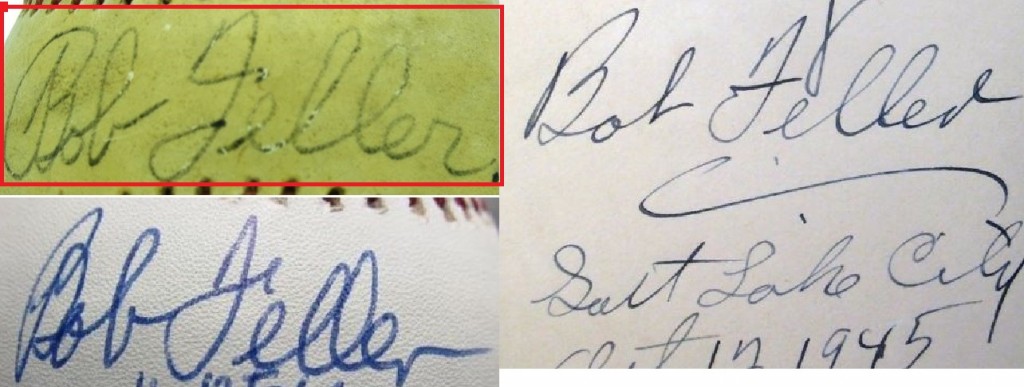
The non-genuine Feller signature on the alleged record baseball (top left) is called a "clubhouse" signature by LOTG Auctions. The signature has more in common with Feller's post-2000 autograph (bottom, left) than it does with an authentic example dated in 1945 (right).
3. Barry Halper’s index cards and letters of authenticity from players regarding game used items in his collection were scattered all throughout the Halper sale at Sotheby’s in 1999 and many other Bob Feller items were accompanied with a supporting statement from Bob Feller describing the provenance of the artifact including: Lot 1102- “The Bob Feller Family Catcher’s Mitt” which came with a signed card reading: ”This is the mitt my father used to catch me when I was a kid….It was this mitt he was using when I threw a fastball in 1934 that hit him in the chest and broke three ribs-as described in TIME Magazine April 19, 1937–Bob Feller”; Lot 1395- a plaster cast of Feller’s hand inscribed, “To Barry from Bob Feller”; Lot 1396- a signed scorecard inscribed, “To Barry Halper, Best to a great pal, Bob Feller”; Lot 1468- Feller’s 1940 Double-Knit Cleveland uniform which was accompanied by a letter from Feller stating: ”To Barry, To my knowledge, this is the first double knit baseball uniform ever made and was sent to me for testing a few years before World War II….”; and Lot 1469- Feller’s “Late 1940’s Indians Warm-Up Jacket” which came with a a letter of authenticity on an index card executed by Feller.

Barry Halper had easy access to Bob Feller and Feller inscribed numerous historic items to him stating the artifact's provenance. Above is his detailed inscription to Halper on his bat which was used by Babe Ruth at his last Yankee Stadium appearance in 1948. (Bob Feller Museum)
Considering that the alleged “fastest-pitched” ball comes with no supporting documentation from Feller; has a forged Feller signature on the sweet spot; and is a non-MLB ball from the American Association, how could the ball be presented definitively as the ball Feller threw on that day in 1946? Even Halper would have questions about this ball if he were buying it in an auction based on an interview he gave to the New York Times in 2000:
”Unless you know it came from a certain player, you’re taking a risk on someone saying it came from Bob Feller and it didn’t….Wherever there is profit to be made, it promotes thievery.”
Crisafulli and LOTG don’t have much to offer in terms of additional evidence supporting that the two balls are genuine and responded to our inquiry about the Ryan ball stating, “Bill Kunkel, who passed away in early 1985, signed and inscribed this baseball as the “record-breaking” ball from the September 7 game in Anaheim. The ball was also signed by Nolan Ryan. The signatures and the Kunkel inscription has been authenticated by both Mike Root at SGC, and by Jimmy Spence, independently of one another. I submitted the ball to both of them for authentication myself. I also contacted Brandon Grunbaum, who confirmed that this style of baseball was in use in the American League in late 1974.”
In regard to the issues related to the Feller ball Al Crisafulli told us, “Why would it not be plausible that the team would have unofficial baseballs used during exhibitions and practice? The Senators played plenty of exhibitions, the Homestead Grays played at Griffith Stadium as well, and there are any number of reasons why an unofficial ball would wind up in a practice bucket in 1946.” As for the bogus Feller autograph on the ball the LOTG auctioneer said, “Not a single letter in that signature looks like it was written by Feller, or even by someone who was attempting to make it look like Feller’s. In an industry where people are making incredible forgeries of six-figure Babe Ruth balls, is it really plausible to think someone would make such a horrible forgery of someone who was still alive, who signed everything he could reach with his pen?” While Crisafulli is now adamant that the Feller signature was not signed to mimic the Hall of Famers autograph he stated the complete opposite on the LOTG blog in April when he wrote, “The adjacent panel is signed both by Feller (on the sweet spot) and catcher George Susce, both vintage signatures.” (The third-party authenticators used by LOTG say the signature of Indians coach George Susce on the ball is genuine and that now appears to be enough for LOTG to consider this ball authentic.)
In addition, Crisafulli also claims that Hauls of Shame’s concerns about these two balls are unwarranted adding, “If this ball didn’t originate with Rob Lifson and Barry Halper, this lot wouldn’t even be on your radar. There are probably pieces up for auction right now that are more worthwhile for you to write about.” Despite the evidence suggesting significant problems with both balls Crisafulli summed up his stance stating, “I’m accepting that they’re real based on the Halper provenance, the appropriate vintage of the balls, the authenticity of the signatures and inscriptions, and how the details of the story jive with those inscriptions.”

Ken Goldin (left) withdrew the suspect Ryan-Feller balls from his sale in 2013 but LOTG's Al Crisafulli (center) doesn't reveal that to his bidders in the addendum to the #1 lot in his current auction (right).
Back in 2013, a Hauls of Shame reader questioned the balls being sold by Goldin and sent us the wire photo of Ryan holding the other ball marked “100.8″ We sent the image to auctioneer Ken Goldin via email and later discussed the Halper provenance and how difficult it would have been to retrieve the 100.8 mph ball on that day in 1974. Goldin responded to our heads up saying, “If there is any question as to the legitimacy of the items themselves, I just do not sell questionable items, so I killed the item and will return to (the) consignor. There is so much great memorabilia we do not need to deal with anything even remotely questionable.”
In their update for the Feller-Ryan lot, Love of the Game admits they were wrong in identifying the ball as the actual Guinness World-Record breaker but they have chosen not to inform their customers that Ken Goldin removed the balls from his prior sale in 2013. Al Crisafulli said, “Were they removed because you showed Ken the wire photo and he didn’t want to deal with being on Haulsofshame.com over an item that would have been a minor lot in his auction? Because if that’s the case, I wouldn’t call that an authenticity issue.”
Ken Goldin did not respond to our inquiry asking him about Crisafulli’s comments and whether both auctioneers had spoken about the Halper baseballs. Crisafulli also did not answer us when we asked him if he and Goldin had spoken before we made our initial inquiry. In his most recent email to us, Crisafulli said, “Ken Goldin reached out to me this afternoon, wondering why I might be speculating on why the Feller/Ryan balls were pulled from his auction. I do not appreciate you putting words in my mouth.”
It should also be noted that Goldin has not responded to several Hauls of Shame inquiries regarding the misrepresented 1960 Ted Williams glove he sold in his last auction and allegations leveled by several sources who contacted Hauls of Shame accusing his consignor, Dr. David Pressman, of having a history of selling bogus Ted Williams items.

